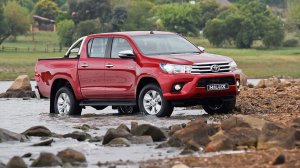The 2017 new-vehicle market will probably end the year “slightly up” on 2016, says Toyota South Africa Motors (TSAM) CEO Andrew Kirby.
TSAM’s forecast is for a market of 552 000 vehicles in 2017, compared with 547 000 units in 2016. At 555 000 units, 2018 does not hold much promise, either.
The small-car segment is the biggest segment in the South African new-passenger car market. Sales in this segment made up 44% of new-car sales in the first half of 2017, holding steady on the 45% recorded in 2007.
Affordability is the key driver in the growth seen in this segment, says Kirby.
Larger C-segment cars, such as the Corolla, have dropped from a 19% share of the new-passenger car market in 2007, to 11% in the first six months of 2017.
Cross-overs and sports-utility vehicles (SUVs) took a 30% share of the new-passenger car market in the first half of 2017, compared with 13% in 2007.
Much of the growth in this popular segment is in line with global sentiment, says Kirby.
South Africa’s light-commercial vehicle (LCV) segment has seen a decline in single-cab workhorse sales, hinting that business and the farming community are under pressure, he adds.
Double-cab sales have increased, however, indicating that the more affluent buyer is supporting this segment of the market.
LCV sales make up around 29% of the South African new-vehicle sales market.
New-single-cab sales dropped from 37% of the LCV segment in 2007, to 30% in the first six months of 2017, with double cabs jumping from 19% of the market in 2007, to 34% in the first half of this year.
Toyota remains the biggest vehicle brand in South Africa, at 22.7% market share, up from 19.1% in 2011.
Kirby believes South Africans are returning to Toyota during the current tough economic times, owing to product reliability and the fact that it is a well-established brand.
He adds that the South African market should continue to grow moderately in the long term, as no significant improvement in public transport is envisaged, and as the burgeoning middle class should continue to support sales.
The same is, however, not true for the African new-vehicle market.
Sales on the continent, outside South Africa, have steadily dropped from 1.079-million new vehicles in 2013, to 641 000 units in 2016, and an expected 592 000 units in 2017.
The sub-Saharan market has declined from 241 000 units in 2013. to 161 000 units in 2016, and an expected 140 000 units in 2017.
The outlook is for the African market to recover to 693 000 in 2018, but for sub-Saharan Africa to slip to 139 000 units in 2018.
Toyota is the dominant exporter to rest of Africa within the stable of South African vehicle manufacturers. This meant it was hardest hit during the global commodity collapse of 2012 and 2013, says Kirby.
“We need the support of the region around us. This is probably the best in the long term,” he notes. “We see Africa as crucial to the growth of the South African automotive industry.”
Kirby adds, however, that it remains a “good question” as to when the African continent will finally evolve into the economic powerhouse so often predicted.
Edited by: Creamer Media Reporter
EMAIL THIS ARTICLE SAVE THIS ARTICLE
ARTICLE ENQUIRY
To subscribe email subscriptions@creamermedia.co.za or click here
To advertise email advertising@creamermedia.co.za or click here













